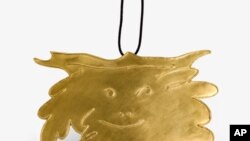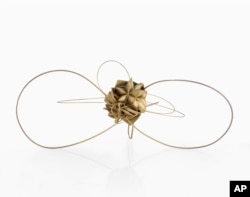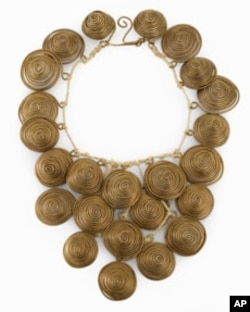Artists such as Pablo Picasso, Alexander Calder and Robert Rauschenberg left behind works of art which are instantly recognizable: Picasso, whose portraits of his lovers merge profile and full face in a disjointed style; Calder with his giant mobiles; and Rauschenberg, famous in the West, with his huge combines made of every day materials and trash.
But few people know these artists also made jewelry. A New York museum has gathered rarely-seen jewels created by Picasso, Calder and many other famous artists.
Of the 200 pendants, brooches and rings at the Museum of Arts and Design, 130 were collected by Diane Venet, a French woman and former journalist.
She didn’t start out thinking she’d collect jewelry by famous artists. But early in life, she fell in love with Bernar Venet, a French sculptor.
“I met my husband 26 years ago,” she says, “and not very long after, he twisted a piece of silver around my finger as a kind of engagement ring. This is the first piece of artist jewelry I had actually.”
Most of Bernar Venet’s friends were artists who exchanged pieces with him. Soon, his wife had jewelry made by artists better known for their larger works, such as the French sculptor Cesar. His trademark was creating huge metal sculptures of crushed cars.
“The germ was within me and I couldn’t help it,” she says. “I went on and on.”
Venet curated the show, “Picasso to Koons: Artist as Jeweler,” which focuses on artists not primarily known for making jewelry.
“The Museum of Arts and Design considers that jewelry is one of the most important art forms in contemporary life. And it cuts across many cultures and gender and race and creed,” says Holly Hotchner, director of the museum. “The idea is not to take a sculpture and then miniaturize it. The idea is to come up with a concept that really relates to the body.”
Picasso, with his Grand Faune pendant, did just that, says Venet about the piece she owns. A faun, in Roman mythology, is half man, half animal, a forest god. Picasso used this fantasized animal in many drawings. His Grand Faune pendant is one of eight Picasso jewels in this exhibit.
Venet believes Picasso’s jewelry shows the artist’s softer side. “I think it’s very special because it’s very personal. Picasso did it because he was in love with Marie Therese Walter, and he gave her a piece. And he was in love with Dora Maar and he did a piece for her. It was a love story, most of the time.”
Calder, the American artist known for his mobiles and wire sculptures, also dabbled in jewelry. A Calder necklace, with his trademark circles, is in the show.
“You would invite Calder for dinner,” says Venet, “and he would come with a piece for a present because he was making them in his studio.”
Sculptor Alberto Giacometti, famous for his ghostly human statues, is represented in the show by two pieces.
As the story goes, he agreed to make buttons for the early 20th century fashion designer Elsa Schiaparelli.
“They were large, three inches ((8 centimeters)) wide, and in bronze," says Venet. "They were much too heavy. So she sent them back to him. He mounted them into brooches and gave them to friends.”
Although Venet never met Giacometti, Picasso or Calder, she did know a number of famous artists including Frank Stella, who she calls a friend. He gave her a necklace of painted gold on titanium.
The exhibit takes visitors through the contemporary period with a tiny platinum bunny on a chain by Jeff Koons, the American artist known for gargantuan sculptures, like the 13-meter high flower-covered puppy that dominated New York’s Rockefeller Center 10 years ago. His style is sometimes called post-pop.
A human-size inflated bunny made of steel was the model for his pendant. Museum director Hotchner says Koons is comfortable working in small scale.
“He certainly has made, and it’s sort of part of his ethic and part of the way he approaches making, that he has made work that is small in scale, enormous in scale,” she says. “So it’s something he would be very comfortable with.”
She points out that not all artists are comfortable making art for the body. Some refused to create jewelry for Venet. Nevertheless, as the exhibit demonstrates, even a tiny piece can be a great work of art.


















